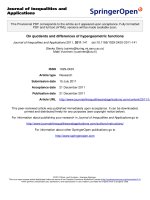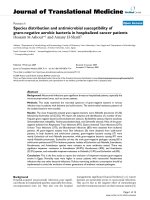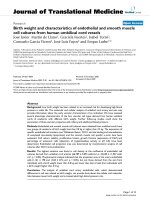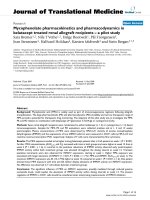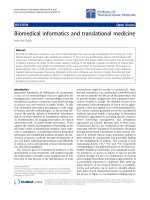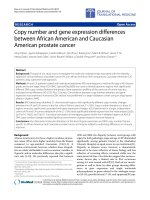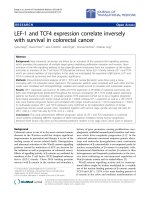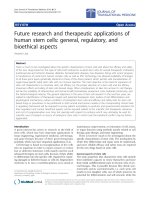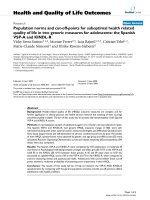báo cáo hóa học: " Maximal COX-2 and ppRb expression in neurons occurs during early Braak stages prior to the maximal activation of astrocytes and microglia in Alzheimer''''s disease" pdf
Bạn đang xem bản rút gọn của tài liệu. Xem và tải ngay bản đầy đủ của tài liệu tại đây (293.16 KB, 5 trang )
BioMed Central
Page 1 of 5
(page number not for citation purposes)
Journal of Neuroinflammation
Open Access
Short report
Maximal COX-2 and ppRb expression in neurons occurs during
early Braak stages prior to the maximal activation of astrocytes and
microglia in Alzheimer's disease
Jeroen JM Hoozemans*
1,5
, Elise S van Haastert
1
, Robert Veerhuis
3,4
,
Thomas Arendt
4
, Wiep Scheper
2
, Piet Eikelenboom
3
and
Annemieke JM Rozemuller
1
Address:
1
Department of Neuropathology, Academic Medical Center, P.O. Box 22700, 1100 DE Amsterdam, The Netherlands,
2
Neurogenetics
Laboratory, Academic Medical Center, University of Amsterdam, Amsterdam, The Netherlands,
3
Department of Psychiatry, VU University medical
center, Amsterdam, The Netherlands,
4
Department of Clinical Chemistry and Alzheimer Center, VU University medical center, Amsterdam, The
Netherlands and
5
Department of Neuroanatomy, Paul Flechsig Institute for Brain Research, University of Leipzig, Leipzig, Germany
Email: Jeroen JM Hoozemans* - ; Elise S van Haastert - ;
Robert Veerhuis - ; Thomas Arendt - ; Wiep Scheper - ;
Piet Eikelenboom - ; Annemieke JM Rozemuller -
* Corresponding author
Alzheimer's diseaseastrocytescell cyclecyclooxygenase-2microgliaretinoblastoma protein
Abstract
Neuronal expression of cyclooxygenase-2 (COX-2) and cell cycle proteins is suggested to
contribute to neurodegeneration during Alzheimer's disease (AD). The stimulus that induces
COX-2 and cell cycle protein expression in AD is still elusive. Activated glia cells are shown to
secrete substances that can induce expression of COX-2 and cell cycle proteins in vitro. Using post
mortem brain tissue we have investigated whether activation of microglia and astrocytes in AD brain
can be correlated with the expression of COX-2 and phosphorylated retinoblastoma protein
(ppRb). The highest levels of neuronal COX-2 and ppRb immunoreactivity are observed in the first
stages of AD pathology (Braak 0–II, Braak A). No significant difference in COX-2 or ppRb neuronal
immunoreactivity is observed between Braak stage 0 and later Braak stages for neurofibrillary
changes or amyloid plaques. The mean number of COX-2 or ppRb immunoreactive neurons is
significantly decreased in Braak stage C compared to Braak stage A for amyloid deposits.
Immunoreactivity for glial markers KP1, CR3/43 and GFAP appears in the later Braak stages and is
significantly increased in Braak stage V-VI compared to Braak stage 0 for neurofibrillary changes. In
addition, a significant negative correlation is observed between the presence of KP1, CR3/43 and
GFAP immunoreactivity and the presence of neuronal immunoreactivity for COX-2 and ppRb.
These data show that maximal COX-2 and ppRb immunoreactivity in neurons occurs during early
Braak stages prior to the maximal activation of astrocytes and microglia. In contrast to in vitro
studies, post mortem data do not support a causal relation between the activation of microglia and
astrocytes and the expression of neuronal COX-2 and ppRb in the pathological cascade of AD.
Published: 21 November 2005
Journal of Neuroinflammation 2005, 2:27 doi:10.1186/1742-2094-2-27
Received: 24 October 2005
Accepted: 21 November 2005
This article is available from: />© 2005 Hoozemans et al; licensee BioMed Central Ltd.
This is an Open Access article distributed under the terms of the Creative Commons Attribution License ( />),
which permits unrestricted use, distribution, and reproduction in any medium, provided the original work is properly cited.
Journal of Neuroinflammation 2005, 2:27 />Page 2 of 5
(page number not for citation purposes)
Findings
Aberrant expression of cyclins, cyclin dependent kinases
(CDKs) and their inhibitors has been observed in post
mitotic neurons in Alzheimer's disease (AD) [1,2]. Pro-
teins that normally function to control cell cycle progres-
sion in actively dividing cells may play a role in the death
of post mitotic neurons in AD [3]. The retinoblastoma pro-
tein (pRb) regulates cell proliferation by controlling pro-
gression through the restriction point within the G1-
phase of the cell cycle [4]. pRb sequesters members of the
E2F gene family of transcription factors. Cell cycle-
dependent phosphorylation of pRb by CDKs inactivates
pRb and inhibits pRb target binding, allowing cell cycle
progression. The expression of phosphorylated pRb
(ppRb) immunoreactivity in AD neurons has previously
been described [5,6]. In the midfrontal and temporal cor-
tex ppRb immunoreactivity can be most prominently
detected in the nucleus of the large pyramidal neurons of
layers III and V, and is rarely detected in neurofibrillary
tangles. Recent studies have shown that neuronal cycloox-
ygenase-2 (COX-2) expression in AD parallels the expres-
sion of cell cycle proteins in neurons [6-8]. Previously, we
observed colocalization of COX-2 with ppRb in neurons
in the temporal cortex of AD and control cases [6].
Increased neuronal COX-2 expression leads to increased
expression of cell cycle mediators in post mitotic neurons,
as shown using a transgenic mouse model with increased
neuronal COX-2 expression [9].
Once activated, microglia and astrocytes are capable of
producing a variety of pro-inflammatory mediators and
potentially neurotoxic substances [10], of which some
have been shown to potentially induce COX-2 and cell
cycle protein expression in vitro [3,11-13]. It has been
shown that interleukin-1β induces COX-2 expression in
neuronal cell models [11,12]. and conditioned medium
from β amyloid (Aβ) peptide stimulated microglia
induces expression of cell cycle proteins in neurons fol-
lowed by cell death [13]. These in vitro findings indicate
that the activation of microglia may play an important
role in the expression of COX-2 and cell cycle proteins in
neurons. Post mortem as well as in vivo studies indicate that
microglial activation already occurs at an early stage in AD
pathology [14,15]. Cell cycle changes and increased neu-
ronal COX-2 expression have also been shown to be early
events in AD [1,7,16,17]. We therefore hypothesized that
neuronal expression of COX-2 and ppRb would be associ-
ated with increased presence and activation of glial cells.
Using post mortem brain tissue we have investigated
whether activation/occurrence of microglia and astrocytes
in AD brain can be correlated with the neuronal expres-
sion of COX-2 and ppRb during AD pathogenesis. Staging
of AD was neuropathologicallly evaluated according to
Braak and Braak [18]. Demographic characteristics of the
cases used in this study are shown in table 1. For each case
the area density of the immunoreactivity for KP1, CR3/43
and GFAP in the mid-temporal cortex was determined.
KP1 (anti-CD68) is a marker for phagocytic microglia
(and macrophages) and CR3/43 detects the class II anti-
gens HLA-DP, DQ, DR and is generally used as a marker
for activated microglia. GFAP (Glial Fibrillary Acidic Pro-
tein) is strongly and specifically expressed in astrocytes.
Group summaries are expressed as box-plots for each
Braak stage for neurofibrillary changes or amyloid depos-
its [18] (figure 1). All three markers show a gradual
increase with increasing pathology. Correlation analysis
reveals a statistically significant (p < 0.05) positive corre-
lation between the Braak scores for neurofibrillary
changes (NF) or Aβ deposits (AMY) and immunoreactiv-
Table 1: Demographic characteristics of the cases used in this study. Shown are differences between groups of the cases used in this
study. [PMI post-mortem interval, SD standard deviation].
Braak score for neurofibrillary changes
O I–II III–IV V–VI
n 516109
male/female 3/2 6/10 0/10 3/6
mean age ± SD (years) 62 ± 10 83 ± 8 89 ± 4 76 ± 7
PMI ± SD (hrs:min) 8:00 ± 4:30 7:30 ± 2:30 6:30 ± 2:30 5:00 ± 1:30
Braak score for amyloid deposits
OA B Ctotal
n 7 6 11 16 40
male/female 4/3 3/3 3/8 2/14 12/28
mean age ± SD (years) 69 ± 12 79 ± 4 85 ± 10 82 ± 10 80 ± 11
PMI ± SD (hrs:min) 7:00 ± 4:00 8:30 ± 3:00 7:00 ± 2:30 6:00 ± 2:00 6:30 ± 2:30
Journal of Neuroinflammation 2005, 2:27 />Page 3 of 5
(page number not for citation purposes)
Immunoreactivity scores for KP1, CR3/43, GFAP, ppRb and COX-2 in the temporal cortex of nondemented control and AD casesFigure 1
Immunoreactivity scores for KP1, CR3/43, GFAP, ppRb and COX-2 in the temporal cortex of nondemented
control and AD cases. Immunohistochemical stainings were performed as described previously [6]. The following primary
antibodies were used: rabbit polyclonal anti-COX-2 (Cayman, Ann Arbor, MI), rabbit anti-phosphoserine pRb (pSer 795, Cell
Signaling, Beverly, MA). Mouse anti-CD68 (KP1) and mouse anti-HLA-DP, DQ, DR (CR3/43) were obtained from DAKO
(Heverlee, Belgium). Mouse anti-Glial Fibrillary Acidic Protein (GFAP) was obtained from Monosan (clone 6F2, Uden, The
Netherlands). Morphometric investigation was aimed at determining the area density occupied by the immunoreactive glial
cells in the cortical layer. The area density (%) was quantified using Image-Pro Plus analysis software (Media Cybernetics, Silver
Spring, MD). Immunoreactive neurons (COX-2 and ppRb) were counted in a total area of 2 mm
2
. Neurons were distinguished
from non-neuronal cells by nuclear size and shape. Values of cases are grouped according to the Braak stage for neurofibrillary
changes (O, I-II, III-IV, V-VI) or Aβ deposits (O, A, B, C). Results are expressed as box plots. The box represents the interquar-
tile range that contains 50% of the values. The whiskers extend from the box to the highest and lowest values. The line across
the box indicates the median. Kruskall-Wallis test was used to evaluate differences between groups followed by the Mann-
Whitney U test, to test differences between pairs of groups. Correlation analysis was done using the Pearson parametric and
Spearman non-parametric method. * p < 0.05 versus Braak stage O. # p < 0.05 versus Braak stage C.
Journal of Neuroinflammation 2005, 2:27 />Page 4 of 5
(page number not for citation purposes)
ity for KP1 (NF, 0.671; AMY, 0.432), CR3/43 (NF, 0.564;
AMY, 0.323), and GFAP (NF, 0.690; AMY, 0.424). A statis-
tically significant increase was observed in Braak stage V-
VI for KP1 (p = 0.001), CR3/43 (p = 0.008), and GFAP (p
< 0.001) compared to Braak stage 0. Neuronal ppRb and
COX-2 immunoreactivity are expressed as number of
immunoreactive neurons per 2 mm
2
(figure 1). A signifi-
cant (p < 0.05) negative correlation was observed between
the Braak score for neurofibrillary changes and ppRb (-
0.414) or COX-2 (-0.346), and between the Braak score
for Aβ plaques and COX-2 (-0.537).
Although it is tempting to assume that these stages reflect
the clinical changes, this study aims to show the relation
between different molecular pathologically defined
events. Cases with Braak stage A used in this study had
either Braak stage I or II for neurofibrillary changes. In
Braak stage A for amyloid low densities of amyloid
plaques are only found in the temporal cortex and other
parts of the isocortex [18]. Activated glial cells are mostly
associated with neuritic plaques not with diffuse Aβ
plaques [10]. This is in agreement with our data which
shows a gradual increase in microglia and astrocytes with
the Braak score for neurofibrillary changes and high levels
of activated glial cells in cases with Braak score B and C
(figure 1).
We observed maximal neuronal ppRb and COX-2 immu-
noreactivity in Braak stages 0 and A. No significant differ-
ence in ppRb and COX-2 immunoreactivity was observed
between the Braak stages for neurofibrillary changes. The
maximal ppRb and COX-2 immunoreactivity in stage A
did not significantly differ from stage O. However, we did
observe a significant decrease in Braak stage C compared
to stage A. These findings contradict previous studies that
have shown increased neuronal COX-2 expression
[19,20] and ppRb immunoreactivity in AD cases [5]. In
the present study the patients are grouped according to the
Braak stage instead of being defined as control or AD.
Other, previously described [17], discrepancies are most
likely due to differences in pathological disease state and
investigated brain area, methods of analysis, as well as
technical issues. The data presented in this study are in
agreement with the findings of Yermakova and O'Banion
[17]. In an immunohistochemical study they found a
decrease in the number of COX-2 immunoreactive neu-
rons in advanced stages of AD. A similar trend, as shown
in the present study, was observed in the hippocampus
comparing the mean neuronal COX-2 immunoreactivity
with the Braak score for NF. A non-significant higher
mean level in Braak stage I-II was also reported [17]. The
levels of neuronal COX-2 expression observed in post mor-
tem brain tissue correlate well with recent clinical data pre-
sented by Combrinck and colleagues [21] describing,
compared to control patients, higher prostaglandin E2
levels in the cerebrospinal fluid in patients with mild
memory impairment, but lower in those with more
advanced AD.
A significant negative correlation was observed between
the area density of KP1 and the immunoreactivity for
ppRb (-0.414, p = 0.007) and COX-2 (-0.366, p = 0.020).
These data suggest no (positive) relation between neuro-
nal expression of COX-2 or ppRb and the increased glial
response observed during AD pathology. Although sug-
gested by in vitro studies, our evaluation of post mortem
brain tissue suggests that it is very unlikely that activation
of microglia or astrocytes cause neuronal expression of
COX-2 and ppRb in AD. Although the involvement of
activated glia in the initial upregulation of these factors
seems unlikely, we cannot exclude the involvement of glia
in the regulation of COX-2 or cell cycle protein expression
in neurons at later stages of pathology.
COX-2 and cell cycle changes can be detected in neurons
that are vulnerable for developing neurodegenerative
changes that are associated with AD [6,16,22]. This
implies that COX-2 and neuronal cell cycle changes occur
in the early steps of AD neurodegeneration. Moreover,
high levels of neuronal COX-2, ppRb, cyclin D1 and cyc-
lin E are found in the temporal cortex of cases which have
diffuse Aβ deposits while fibrillar/neuritic plaques are
absent [6,7]. Various in vitro studies using neuronal mod-
els show that Aβ peptide induces COX-2 [20] and phos-
phorylation of pRb [23,24], which is followed by
neuronal cell death. In this perspective, the current emerg-
ing data on the early role of oligomeric and protofibrilic
forms of Aβ in AD is very interesting [25,26]. Whether
COX-2 and cell cycle proteins are part of the molecular
mechanisms involved in the response to intraneuronal
accumulation of Aβ and the consequent impaired synap-
tic function needs to be addressed in future studies.
Competing interests
The author(s) declare that they have no competing inter-
ests.
Authors' contributions
JJMH participated in the design of the study, performed
the statistical analysis and prepared the manuscript. ESvH
carried out the immunohistochemical analyis and quanti-
fication of the immunohistochemical data. RV has been
involved in the collection of the human post mortem
brain material. TA, WS, PE and AJMR participated in the
design of the study and helped to draft the manuscript. All
authors read and approved the final manuscript.
Acknowledgements
The authors thank the Netherlands Brain Bank for supplying the human
brain tissue (coordinator Dr. R. Ravid) and Dr. W. Kamphorst for the neu-
ropathological diagnosis of control and AD tissue. This study was sup-
Publish with BioMed Central and every
scientist can read your work free of charge
"BioMed Central will be the most significant development for
disseminating the results of biomedical research in our lifetime."
Sir Paul Nurse, Cancer Research UK
Your research papers will be:
available free of charge to the entire biomedical community
peer reviewed and published immediately upon acceptance
cited in PubMed and archived on PubMed Central
yours — you keep the copyright
Submit your manuscript here:
/>BioMedcentral
Journal of Neuroinflammation 2005, 2:27 />Page 5 of 5
(page number not for citation purposes)
ported by the Internationale Stichting Alzheimer Onderzoek (ISAO grant
04503 to JJMH) and the European Community (ADIT programme, LSHB-
CT-511977 to AJMR).
References
1. Nagy Z, Esiri MM, Cato AM, Smith AD: Cell cycle markers in the hip-
pocampus in Alzheimer's disease. Acta Neuropathol (Berl) 1997,
94:6-15.
2. Arendt T, Rodel L, Gartner U, Holzer M: Expression of the cyclin-
dependent kinase inhibitor p16 in Alzheimer's disease. Neu-
roreport 1996, 7:3047-3049.
3. Arendt T: Synaptic plasticity and cell cycle activation in neu-
rons are alternative effector pathways: the 'Dr. Jekyll and
Mr. Hyde concept' of Alzheimer's disease or the yin and yang
of neuroplasticity. Prog Neurobiol 2003, 71:83-248.
4. Sherr CJ: Cancer cell cycles. Science 1996, 274:1672-1677.
5. Jordan-Sciutto KL, Malaiyandi LM, Bowser R: Altered distribution
of cell cycle transcriptional regulators during Alzheimer dis-
ease. J Neuropathol Exp Neurol 2002, 61:358-367.
6. Hoozemans JJ, Veerhuis R, Rozemuller AJ, Arendt T, Eikelenboom P:
Neuronal COX-2 expression and phosphorylation of pRb
precede p38 MAPK activation and neurofibrillary changes in
AD temporal cortex. Neurobiol Dis 2004, 15:492-499.
7. Hoozemans JJ, Bruckner MK, Rozemuller AJ, Veerhuis R, Eikelen-
boom P, Arendt T: Cyclin D1 and cyclin E are co-localized with
cyclo-oxygenase 2 (COX-2) in pyramidal neurons in Alzhe-
imer disease temporal cortex. J Neuropathol Exp Neurol 2002,
61:678-688.
8. Mirjany M, Ho L, Pasinetti GM: Role of cyclooxygenase-2 in neu-
ronal cell cycle activity and glutamate-mediated excitotoxic-
ity. J Pharmacol Exp Ther 2002, 301:494-500.
9. Xiang Z, Ho L, Valdellon J, Borchelt D, Kelley K, Spielman L, Aisen PS,
Pasinetti GM: Cyclooxygenase (COX)-2 and cell cycle activity
in a transgenic mouse model of Alzheimer's disease neu-
ropathology. Neurobiol Aging 2002, 23:327-334.
10. Akiyama H, Barger S, Barnum S, Bradt B, Bauer J, Cole GM, Cooper
NR, Eikelenboom P, Emmerling M, Fiebich BL, Finch CE, Frautschy S,
Griffin WS, Hampel H, Hull M, Landreth G, Lue L, Mrak R, Mackenzie
IR, McGeer PL, O'Banion MK, Pachter J, Pasinetti G, Plata-Salaman C,
Rogers J, Rydel R, Shen Y, Streit W, Strohmeyer R, Tooyoma I, Van
Muiswinkel FL, Veerhuis R, Walker D, Webster S, Wegrzyniak B,
Wenk G, Wyss-Coray T: Inflammation and Alzheimer's dis-
ease. Neurobiol Aging 2000, 21:383-421.
11. Fiebich BL, Mueksch B, Boehringer M, Hull M: Interleukin-1beta
induces cyclooxygenase-2 and prostaglandin E(2) synthesis
in human neuroblastoma cells: involvement of p38 mitogen-
activated protein kinase and nuclear factor-kappaB. J Neuro-
chem 2000, 75:2020-2028.
12. Hoozemans JJ, Veerhuis R, Janssen I, Rozemuller AJ, Eikelenboom P:
Interleukin-1beta induced cyclooxygenase 2 expression and
prostaglandin E2 secretion by human neuroblastoma cells:
implications for Alzheimer's disease. Exp Gerontol 2001,
36:559-570.
13. Wu Q, Combs C, Cannady SB, Geldmacher DS, Herrup K: Beta-
amyloid activated microglia induce cell cycling and cell death
in cultured cortical neurons. Neurobiol Aging 2000, 21:797-806.
14. Arends YM, Duyckaerts C, Rozemuller JM, Eikelenboom P, Hauw JJ:
Microglia, amyloid and dementia in alzheimer disease. A
correlative study. Neurobiol Aging 2000, 21:39-47.
15. Cagnin A, Brooks DJ, Kennedy AM, Gunn RN, Myers R, Turkheimer
FE, Jones T, Banati RB: In-vivo measurement of activated micro-
glia in dementia. Lancet 2001, 358:461-467.
16. Busser J, Geldmacher DS, Herrup K: Ectopic cell cycle proteins
predict the sites of neuronal cell death in Alzheimer's dis-
ease brain. J Neurosci 1998, 18:2801-2807.
17. Yermakova AV, O'Banion MK: Downregulation of neuronal
cyclooxygenase-2 expression in end stage Alzheimer's dis-
ease. Neurobiol Aging 2001, 22:823-836.
18. Braak H, Braak E: Neuropathological stageing of Alzheimer-
related changes. Acta Neuropathol (Berl) 1991, 82:239-259.
19. Oka A, Takashima S: Induction of cyclo-oxygenase 2 in brains of
patients with Down's syndrome and dementia of Alzheimer
type: specific localization in affected neurones and axons.
Neuroreport 1997, 8:1161-1164.
20. Pasinetti GM, Aisen PS: Cyclooxygenase-2 expression is
increased in frontal cortex of Alzheimer's disease brain. Neu-
roscience 1998, 87:319-324.
21. Combrinck M, Williams J, De Berardinis MA, Warden D, Puopolo M,
Smith AD, Minghetti L: Levels of CSF prostaglandin E2, cogni-
tive decline and survival in Alzheimer's disease. J Neurol Neu-
rosurg Psychiatry 2005.
22. Yang Y, Mufson EJ, Herrup K: Neuronal cell death is preceded by
cell cycle events at all stages of Alzheimer's disease. J Neurosci
2003, 23:2557-2563.
23. Giovanni A, Wirtz-Brugger F, Keramaris E, Slack R, Park DS: Involve-
ment of cell cycle elements, cyclin-dependent kinases, pRb,
and E2F x DP, in B-amyloid-induced neuronal death. J Biol
Chem 1999, 274:19011-19016.
24. Copani A, Condorelli F, Caruso A, Vancheri C, Sala A, Giuffrida Stella
AM, Canonico PL, Nicoletti F, Sortino MA: Mitotic signaling by
beta-amyloid causes neuronal death. Faseb J 1999,
13:2225-2234.
25. Klyubin I, Walsh DM, Lemere CA, Cullen WK, Shankar GM, Betts V,
Spooner ET, Jiang L, Anwyl R, Selkoe DJ, Rowan MJ: Amyloid beta
protein immunotherapy neutralizes Abeta oligomers that
disrupt synaptic plasticity in vivo. Nat Med 2005, 11:556-561.
26. Gouras GK, Almeida CG, Takahashi RH: Intraneuronal Abeta
accumulation and origin of plaques in Alzheimer's disease.
Neurobiol Aging 2005, 26:1235-1244.
